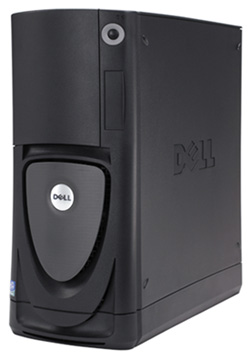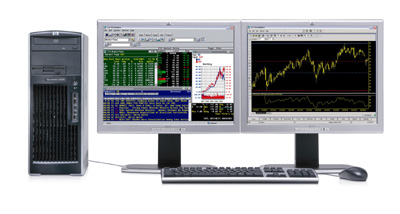EM64T and Beyond
Intel's new Pentium 4 and Xeon processors offer a combination of fundamentallynew architectural elements to form the basis for a new generation of workstations.
Latest News
December 1, 2004
By Mark Clarkson
Intel’s EM64T (Extended Memory 64 Technology) is all about addressing vast amountsof memory, 64 bits worth to be exact. With 32 bits, you can only address a paltry4GB worth of memory; but with 64 bits you can address 16 exabytes (16 billiongigabytes)!
It’s unlikely any of us will be able to afford that much RAM in the near future,and none of today’s hardware even pretends to support those kinds of numbers,though Intel has talked about addressing a few hundred terabytes. Still, 64 bitsshould hold most of us for a while. Physical and Virtual Memory
Physical and Virtual Memory
The simplest reason for you to purchase an EM64T system is to pack more physicalRAM. If your data sets exceed the 32-bit, 4GB boundaries of your current workstation,then you are definitely a customer for 64-bit technology. EM64T also amelioratesthe less obvious, virtual memory problem. Consider: 32-bit architectures theoreticallyaddress up to 4GB of memory. In reality, even if you have 4GB of RAM onboard,you can’t get at all of it. That’s because all of your hardware—your graphicscard, your I/O cards, everything—has to be mapped into that 4GB memory space.
“In the last nine months or so, we’ve seen a real increase in the number of peoplecomplaining that they can’t access all of their memory,” says Mike Diehl at HPWorkstations. “Large graphics cards with, say, 256 megabytes of memory, are typicallyyour worst offenders,” says Diehl. “Those cards all support dual displays, sothey really need to map to half a gigabyte. Right there, you’re down to 3.5 gigabytes.
Dell Precision Workstation 670 is powered by a 3.4GHz
Integrated PCI-X 64-bit Intel Xeon processor.
Typically the customers with 4 gigabytes of RAM find they have access to 3 gigabytesor less.”
Device drivers and other applications fragment the memory, compounding the problem.With EM64T and a 64-bit operating system, you’re able to organize virtual-memoryaddressing more efficiently, so that you can use more of the memory that you dohave.
For the many Windows users among us, this all seems moot; Windows can’t handle64-bit addresses, no matter what the underlying hardware. That’s soon to change:the 64-bit edition of Windows XP (currently in beta testing) is expected thissummer. 64-bit Linux is already widely available on desktop workstations.
Backward Compatibility
If you genuinely don’t need more memory, physical or virtual, you can still run32-bit applications under your 32-bit operating system; EM64T is fully backwardcompatible.
You can also run 32-bit applications under a 64-bit operating system, or runa mixture of 32- and 64-bit applications. “This ability to mix 32-bit and 64-bitapplications is really the bridge that gives customers the capability to adoptthis as they go, and as the applications become available,” says HP’s Diehl.
At the very least, EM64T provides an insurance policy. “In the future,” saysJoe Curley at Dell, “you might have larger data sets, or need to run multipleapplications, or run into performance issues, or you might upgrade at some pointto use the same equipment in a 64-bit configuration down the road. ... And there’sno penalty for EM64T. We’re not charging you more for it.”
DDR2 In The Future
On the subject of memory, Intel’s latest generation of chips also supports theDDR2 RAM standard, the successor to DDR.
Physically limited to 400MHz, DDR RAM technology has hit its ceiling; it simplycan’t run any faster. DDR2’s speed, on the other hand, starts at 400MHz, and DDR2chips are shipping with speeds as high as 533MHz already. (You might have heardof some video cards using DDR2 memory. This was developed for the video card marketand is therefore different from workstation DDR2.)
DDR2 uses 240-pin modules, compared to the 184-pins of current DDR modules, meaningthey are not backward compatible. DDR2 also consumes significantly less powerthan DDR RAM, and is better organized for larger amounts of RAM in the future,all important in a post-4GB world.
DDR2 memory modules start off at 256MB capacities, with 512MB and 1GB available.The standard is capable of handling higher-density modules up to 4GB. Higher capacitiesshould be achieved in the future. DDR2 looks sure to be the new mainstream RAMtechnology for the foreseeable future, for desktop PCs as well as workstations.
The HP xw6200 with Intel’s Xeon processor includes an 800MHz system bus (6.4GBpsbandwidth), a dual channel PC3200 DDR2-400 SDRAM memory subsystem, and supportsup to eight monitors.
PCI Express, A Scalable Architecture
Intel’s new chips also support the successor to the aging PCI bus: PCI Express,which replaces PCI’s broad, parallel architecture with a point-to-point serialbus. The basic connector, PCI Express x1 (“by one”), will sustain a data transferrate of about 250MBps, which compares favorably to PCI’s rate of about 133MBps.(Also see “PCI Express 101” on page 38.)
But PCI Express is a scalable architecture. In addition to x1, it comes in x4(four times the bus width, four times the bandwidth), and x16, which will pumpup to 250MB times 16, or 4GBps.
Instead of every device sharing bandwidth on a single bus (à la PCI), each PCIExpress device receives dedicated bandwidth to the system. Small bandwidth consumers—modems,NIC cards, and so forth—can easily make do with a x1 slot. Devices with higherbandwidth requirements—high-performance data acquisition cards, high-speed SCSIarrays, etc.—can step up to a x4. Really bandwidth-hungry devices can plug intoa x16. PCI Express x16 connectors are already replacing AGP (accelerated graphicsport) slots for graphics cards.
Workstation manufacturers can design their systems so that devices don’t getin each other’s way. “Having PCI Express in the box is a huge architectural breakthrough,“says Dell’s Curley.
A Good Time to make the Transition
All in all, it’s a good time to move up to a new workstation. “There is a lotin this generation of workstations that really enables productivity,” says Curley.“There is a whole series of new technologies for you to take advantage of. EM64Tis very important, it solves one particular set of problems for a particular classof users, but these other technologies are every bit as good a reason for upgradingyour workstation.”
Mark Clarkson is a contributing editor for Desktop Engineering. His most recent books, PhotoshopElements by Example and Photoshop Secrets of the Pros, reflect his current obsessionwith computer art. Send him your comments via e-mail c/o [email protected].






